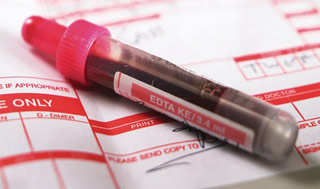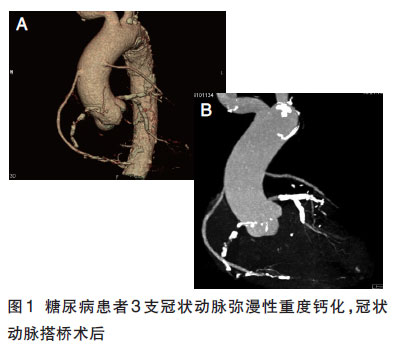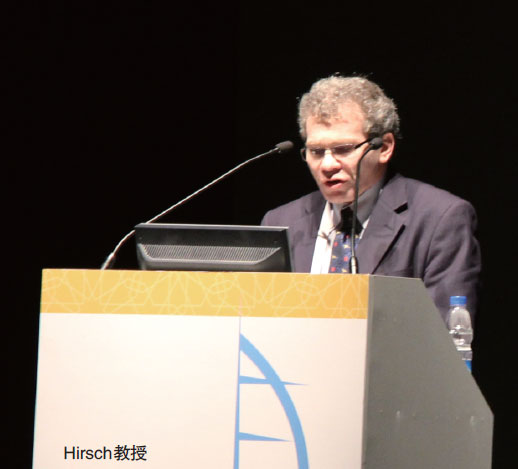AIM:糖尿病伴肾病者必须控制好HbA1c水平
2011-12-12 MedSci原创 MedSci原创
美国阿拉贝塔大学的一组研究人员通过观察性研究发现,患有糖尿病和3或4期慢性肾脏疾病的患者,糖化血红蛋白(HbA1c)水平过高和过低均与预后差有关。其研究结果近日被发表在《内科学文献》(Archives of Internal Medicine)杂志上。 阿拉贝塔大学的Marcello Tonelli博士指出,糖化血红蛋白水平过高与一系列临床事件有关,包括高死亡风险、肾脏疾病恶化、新的终末期肾脏疾

美国阿拉贝塔大学的一组研究人员通过观察性研究发现,患有糖尿病和3或4期慢性肾脏疾病的患者,糖化血红蛋白(HbA1c)水平过高和过低均与预后差有关。其研究结果近日被发表在《内科学文献》(Archives of Internal Medicine)杂志上。
阿拉贝塔大学的Marcello Tonelli博士指出,糖化血红蛋白水平过高与一系列临床事件有关,包括高死亡风险、肾脏疾病恶化、新的终末期肾脏疾病、心血管意外、以及住院治疗等。但实际上,HbA1c水平过低(低于6.5%)也与高死亡率有关。
在今年11月美国肾脏病学会(ASN)年会上,有2项观察性研究结果支持这一结论,这些研究结果显示,患有终末期肾脏疾病的糖尿病患者,其HbA1c水平在超过6%到9%的范围时,死亡率会增高。
HbA1c降至7%以下可以减缓糖尿病患者肾脏疾病的进展,美国国家肾脏基金会的肾脏疾病预后控制计划(KDOQI)也建议使患者达到该目标,而无论其肾功能如何。但是慢性肾脏疾病患者大多被排除在血糖控制试验之外。
ACCORD试验结果显示,通过强化治疗使HbA1c降至6%以下会导致2型糖尿病患者的死亡率增加,该试验排除了肌酐水平过高的患者,而且其中大多数患者都患有慢性肾脏疾病。
研究人员将23296名患3或4期肾脏疾病的1或2型糖尿病患者纳入试验,他们将这些患者按照首次测得的HbA1c水平进行分层,其中位HbA1c水平为6.9%,11%的患者HbA1c水平高于9%。
随后研究者对这些患者进行了长达4年的随访,16%的患者死亡,49%的患者住院治疗,16%的患者出现了心血管意外,6%的患者肾脏疾病出现了进展,2%发展成为终末期肾脏疾病。在进行了一些列分析后,研究人员发现,高HbA1c水平与前述5个临床事件有关。死亡率呈U型曲线,在HbA1c低于 6.5%和高于8%时增大。
Tonelli指出,发生终末期肾脏疾病的风险与患者一开始患慢性肾脏疾病高度相关,其肾脏功能不可逆转,而且仅仅通过控制血糖并不能阻止其肾脏疾病的进展。(生物谷bioon.com)
Association Between Glycemic Control and Adverse Outcomes in People With Diabetes Mellitus and Chronic Kidney Disease
Sabin Shurraw, MD; Brenda Hemmelgarn, MD, PhD; Meng Lin, MSc; Sumit R. Majumdar, MD, MSc; Scott Klarenbach, MD, MSc; Braden Manns, MD, MS; Aminu Bello, MD, PhD; Matthew James, MD, PhD; Tanvir Chowdhury Turin, MD, PhD; Marcello Tonelli, MD, SM; for the Alberta Kidney Disease Network.
Background Better glycemic control as reflected by lower hemoglobin A1c (HbA1c) level may prevent or slow progression of nephropathy in people with diabetes mellitus (DM). Whether a lower HbA1c level improves outcomes in people with DM and chronic kidney disease (CKD) is unknown.
Methods From all people with serum creatinine measured as part of routine care in a single Canadian province from 2005 through 2006, we identified those with CKD based on laboratory data (estimated glomerular filtration rate [eGFR], <60.0 mL/min/1.73 m2]) and DM using a validated algorithm applied to hospitalization and claims data. Patients were classified based on their first HbA1c measurement; Cox regression models were used to assess independent associations between HbA1c level and 5 study outcomes (death, progression of kidney disease based on a doubling of serum creatinine level, or new end-stage renal disease [ESRD], cardiovascular events, all-cause hospitalization).
Results We identified 23 296 people with DM and an eGFR lower than 60.0 mL/min/1.73 m2. The median HbA1c level was 6.9% (range, 2.8%-20.0%), and 11% had an HbA1c value higher than 9%. Over the median follow-up period of 46 months, 3665 people died, and 401 developed ESRD. Regardless of baseline eGFR, a higher HbA1c level was strongly and independently associated with excess risk of all 5 outcomes studied (P < .001 for all comparisons). However, the association with mortality was U-shaped, with increases in the risk of mortality apparent at HbA1c levels lower than 6.5% and higher than 8.0%. The increased risk of ESRD associated with a higher HbA1c level was attenuated at a lower baseline eGFR (P value for interaction, <.001). Specifically, among those with an eGFR of 30.0 to 59.9 mL/min/1.73 m2, the risk of ESRD was increased by 22% and 152% in patients with HbA1c levels of 7% to 9% and higher than 9%, respectively, compared with patients with an HbA1c level lower than 7% (P < .001), whereas corresponding increases were 3% and 13%, respectively, in those with an eGFR of 15.0 to 29.9 mL/min/1.73 m2.
Conclusions A hemoglobin A1c level higher than 9% is common in people with non–hemodialysis-dependent CKD and is associated with markedly worse clinical outcomes; lower levels of HbA1c (<6.5%) also seemed to be associated with excess mortality. The excess risk of kidney failure associated with a higher HbA1c level was most pronounced among people with better kidney function. These findings suggest that appropriate and timely control of HbA1c level in people with DM and CKD may be more important than previously realized, but suggest also that intensive glycemic control (HbA1c level <6.5%) may be associated with increased mortality.
本网站所有内容来源注明为“梅斯医学”或“MedSci原创”的文字、图片和音视频资料,版权均属于梅斯医学所有。非经授权,任何媒体、网站或个人不得转载,授权转载时须注明来源为“梅斯医学”。其它来源的文章系转载文章,或“梅斯号”自媒体发布的文章,仅系出于传递更多信息之目的,本站仅负责审核内容合规,其内容不代表本站立场,本站不负责内容的准确性和版权。如果存在侵权、或不希望被转载的媒体或个人可与我们联系,我们将立即进行删除处理。
在此留言












#HbA#
95